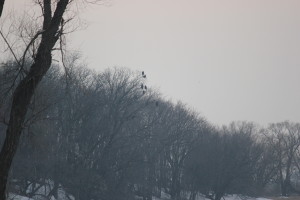Opponents hope to stop MN wind farm on wings of eagles

By Tom Steward | Watchdog Minnesota Bureau
CORNISH TOWNSHIP, Minn. — The last hope for rural residents opposing a proposed 10-turbine wind farm planned in this southern Minnesota county may rest on the wings of eagles — as well as swans, pelicans, harriers, ducks and bats.
With the Indiana-based developer already holding a state permit to proceed, it could be too late for a core group of about 75 opponents and perhaps some of the migratory birds and waterfowl they have photographed within range of the renewable power project’s 1,600-acre footprint.
“The fact is that thousands of birds use the specific area where turbines are proposed as a migratory stopover before they move into either the Mississippi River flyway or the Atlantic flyway,” said Barb Wenninger, a Cornish Township resident and longtime opponent of the project. “…I think it is important to have accurate information on avian use before we are faced with the law of unintended consequences and lose entire flocks of birds.”
ON EAGLES’ WINGS? Questions about the vulnerability of the group of eagles caught on camera within range of a proposed 20 megawatt MN wind farm have led to further studies of the avian risk.
The potential impact on protected species, other birds and bats surfaced in recent months as the latest challenge to the on-again, off-again 20-megawatt Sibley County Substation wind project on the drawing board since 2005. The state representative for the area also opposes the wind farm.
“I’m against it primarily because of the high subsidies that they get per kilowatt hour comparatively,” said Rep. Glenn Gruenhagen, R-Glencoe. “Also because they’re inefficient and not a reliable source of electricity.”
Complaints filed with the Minnesota Public Utilities Commission over out-of-state ownership and potential adverse health impact from turbine noise have been successfully rebutted by the developer, Wesco Wind.
Company officials didn’t respond to a Watchdog Minnesota Bureau inquiry. In the April 16 edition of the Henderson Independent, however, Steve Estes, president of Sibley Wind Substation LLC, criticized opponents. “It’s the tea party mentality that’s driving the opposition right now. That’s all it is,” Estes said.
Residents’ photographs depict bald eagles within a mile of the proposed locations for some of the 400-foot-tall turbines. Other pictures show hundreds of migrating ducks and swans attracted to plowed fields that collect ponds of melted snow each spring.
Similar controversies over kill rates of protected species and raptors recently led the Obama administration to extend federal legal protection to the wind industry for turbine-killed bald and golden eagles from five to 30 years.
Concerns over the impact on eagles and bats helped halt a proposed wind farm last year in Goodhue County. An attorney who counseled Goodhue County landowners and represents Cornish Township in opposing the Sibley County project sees similarities.
“You have the Migratory Bird Act involved with the flyway that goes through Cornish Township,” said attorney Dan Schleck. ”So could it hold it up? It has the potential to. Is it probable it will hold it up? I can’t tell you. I don’t know where the DNR is at on this or the U.S. Fish and Wildlife Service.”
An April 9 Wesco Wind letter to Cornish Township residents hints at further federal involvement in assessing the potential environmental impact. U.S. Fish and Wildlife officials in Minneapolis didn’t respond to a Watchdog Minnesota Bureau inquiry.
“We have also consulted with the U.S. Fish and Wildlife Service again about the project,” said Estes in the letter. “Even though we have complied with all environmental requirements for the project, we have commissioned additional voluntary studies USF&W would like to see done in order to be certain there are no avian risks.”
The letter criticized Cornish Township for withdrawing support for a road agreement critical to moving the wind farm forward as soon as developers would like.
“We feel that this legal conflict is counterproductive and costly for everyone. The tax revenue that will be paid by the Sibley Wind Substation project to the Township would represent, by a conservative estimate, 14% of the total Township’s annual budget,” said Estes’ letter. “Township residents could either see their tax levy reduced or their road improvement budget increased by the amount of tax paid by the project.”
Yet no economic benefit would be sufficient to offset some residents’ concerns over the wind farm’s impact on their property values and quality of life.
“All you can do is voice your opinion and try to stick up for what you think is right,” said landowner and project opponent Dale Henderson. “And obviously, wildlife doesn’t have much of a voice in this, unless you speak up for them. So that’s what we’re trying to do.”
Contact Tom Steward at tsteward@watchdog.org.







